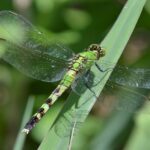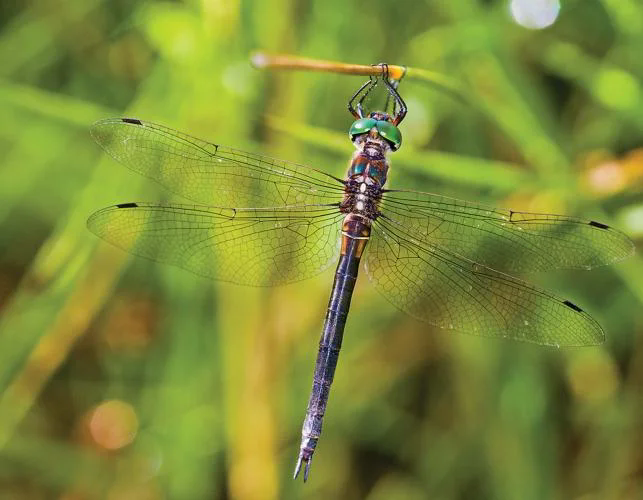
The Hine’s emerald dragonfly (Somatochlora hineana), also known as Ohio emerald, Hine’s bog skimmer and hook-tipped emerald, is among the most endangered dragonflies in the United States.
Dragonflies and damselflies are characterized by two pairs of large membranous wings; large compound eyes; short, bristle-like antennae; chewing mouth parts; slender, elongate abdomens; and male secondary reproductive organs.
hine’s emerald dragonfly life cycle
The life cycle of Hine’s emerald dragonfly is similar to most dragonflies in that it is comprised of the following stages: aquatic egg, aquatic larva and a terrestrial / aerial adult as described by Corbet in 1962. A Hine’s emerald dragonfly female will most likely lay more than 500 eggs during her life noted D. Soluk, with the Illinois Natural History Survey in 1999. After an egg is hatched, the larvae may spend 2 to 4 years in small streamlets, foraging and molting as they grow, noted Soluk and others in 1996 and again in 1998. Upon completion of larval development, the larvae begin to emerge as adults, possibly as early as late May in Illinois and late June in Wisconsin, and continue to emerge throughout the summer noted Vogt and Cashatt in 1994 and others in the late 1990s.
The first emergence date can be estimated using temperature and precipitation data documents Mierzwa and others in 1995. The Hine’s emerald dragonfly’s known flight season lasts up to early October in Illinois, as documented by Vogt and Cashatt in 1994, and later by Soluk and others in 1996. Populations in Wisconsin were documented by Vogt and Cashatt to have flight season through late August. Soluk and others documented in 1996 that fully adult Hine’s emerald dragonflies can live at least 14 days, and Mierzwa and others documented that they may live four to six weeks.
As with most dragonflies, adult Hine’s emerald dragonflies feed, establish territories, mate and oviposit, or lay eggs as observed by Corbet in 1962. Most dragonfly adults are general predators throughout their entire life cycle, feeding primarily on insects they can capture while flying.
Hine’s emeralds occupy wetland, pond and pool, wet meadow, forest, and marsh habitats.A few important characteristics are common to typical Hine’s emerald habitats. First, Hine’s emerald habitats include slow-moving, mineralized streams. Second, they have both open and wooded areas. Open areas provide space for foraging. Wooded areas provide space for resting. Third, they include crayfish burrows, which nymphs use for shelter. Fourth, typical habitats possess exposed or lightly covered bedrock.Finally, they provide pathways for Hine’s emerald dispersal. Roadways, forest clearings, streams, and railroads all serve as dispersal pathways. Other characteristics of Hine’s emerald habitats, such as vegetation, vary between regions.
The Hine’s emerald’s current range includes parts of the United States and Canada. Within the United States, the Hine’s emerald’s range includes Illinois, Michigan, Missouri and Wisconsin. Within Canada, the Hine’s emerald’s range includes parts of Ontario. The Hine’s emerald historically also occupied parts of Ohio, Indiana, and Alabama. Due to habitat modification, the Hine’s emerald likely no longer live in these states. Whether the Hine’s emerald once lived in parts of other states is currently unknown.
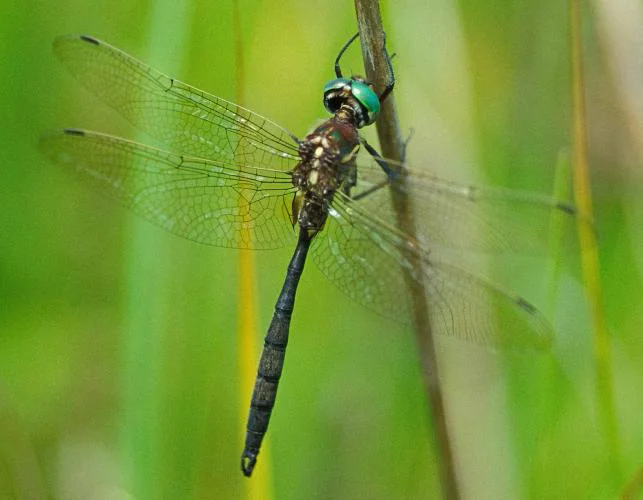
Hine’s emerald dragonflies were first described in 1931 near Indian Lake in Logan County, Ohio.The IUCN Red List states that there are 47 known locations where Hine’s emeralds are present. This includes Ontario, Canada, and Illinois, Michigan, Missouri, and Wisconsin.Populations at one point also existed in Ohio, Alabama, and Indiana, though there have been no recent sightings.
During their lifespans, Hine’s emeralds progress through the egg stage, larval stage, and adult stage. Both the egg and larval stages are aquatic. Hine’s emeralds spend the majority of this lifespan in the larval stage, which lasts 2–4 years.The specific length of this stage varies with food supply, water depth, and temperature. While in this stage, Hine’s emerald nymphs live within streamlets and mature by undergoing a series of molts. A mature larvae transitions into the adult stage by climbing up onto a cattail and completing a final molt.During this molt, the nymph’s skin splits longitudinally along its body. The adult then sheds this dead skin and emerges into the wild. Nymphs typically emerge into the wild during June and July. Male and female nymphs appear to progress into the adult stage in equal proportions. The following 4-to-6-week-long adult stage consists of three sub-stages. These stages are the pre-reproductive stage, reproductive stage, and post-reproductive stage. Adults spend these stages hunting for prey, establishing territories, and reproducing. Overall, Hine’s emerald dragonflies live for 2–4 years.
hine’s emerald dragonfly habitat
Hine’s emerald dragonfly lives in wetlands that are dominated by graminoid, or grass-like plants, and fed primarily by water from a mineral source or fens as F. Swink and G. Wilhelm documented in 1994. Three important characteristics common to wetlands that are inhabited by Hine’s emerald dragonfly appear to be groundwater fed, with shallow water that is slowly flowing through vegetation, dolomitic bedrock or calcareous limestone, and co-inhabited by crayfish, like devil crayfish (Lacunicambarus diogenes). The flowing water can range from barely detectable sheet flow to deeper, small well-defined streamlet channels. Parts of the streamlet channels are usually covered by vegetation such as cattails or sedges. These slow-moving aquatic systems provide appropriate habitat for larval development. Soil types of these aquatic systems can range from organic muck to mineral soils like marl. Two other important components of these wetland complexes are open, vegetated areas and nearby or adjacent forest edge and uplands. Areas of open vegetation serve as places to forage. Forest edge, trees or shrubs, near or adjacent, to fens provide areas which may concentrate prey and provide protected areas for Hine’s emerald dragonfly to perch and roost.
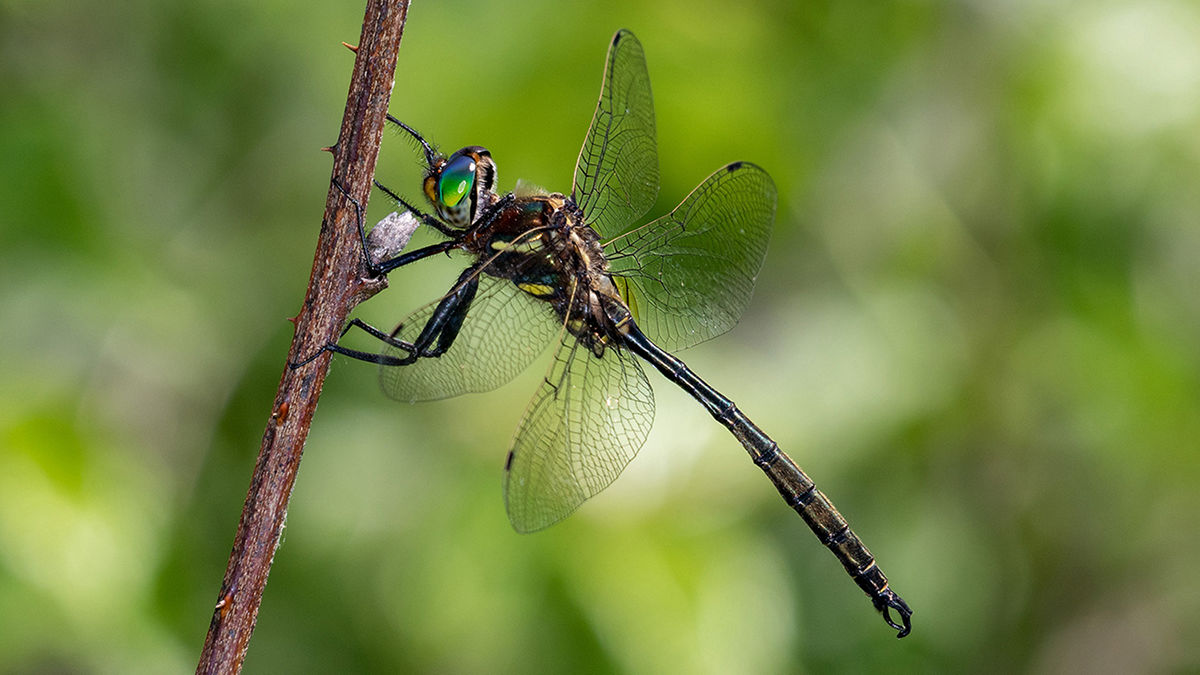
Hine’s emeralds occupy wetland, pond and pool, wet meadow, forest, and marsh habitats.A few important characteristics are common to typical Hine’s emerald habitats. First, Hine’s emerald habitats include slow-moving, mineralized streams. Second, they have both open and wooded areas. Open areas provide space for foraging. Wooded areas provide space for resting. Third, they include crayfish burrows, which nymphs use for shelter. Fourth, typical habitats possess exposed or lightly covered bedrock.Finally, they provide pathways for Hine’s emerald dispersal. Roadways, forest clearings, streams, and railroads all serve as dispersal pathways. Other characteristics of Hine’s emerald habitats, such as vegetation, vary between regions.
The Hine’s emerald’s current range includes parts of the United States and Canada. Within the United States, the Hine’s emerald’s range includes Illinois, Michigan, Missouri and Wisconsin. Within Canada, the Hine’s emerald’s range includes parts of Ontario. The Hine’s emerald historically also occupied parts of Ohio, Indiana, and Alabama. Due to habitat modification, the Hine’s emerald likely no longer live in these states. Whether the Hine’s emerald once lived in parts of other states is currently unknown.
Hine’s emerald dragonflies were first described in 1931 near Indian Lake in Logan County, Ohio.The IUCN Red List states that there are 47 known locations where Hine’s emeralds are present. This includes Ontario, Canada, and Illinois, Michigan, Missouri, and Wisconsin.Populations at one point also existed in Ohio, Alabama, and Indiana, though there have been no recent sightings.
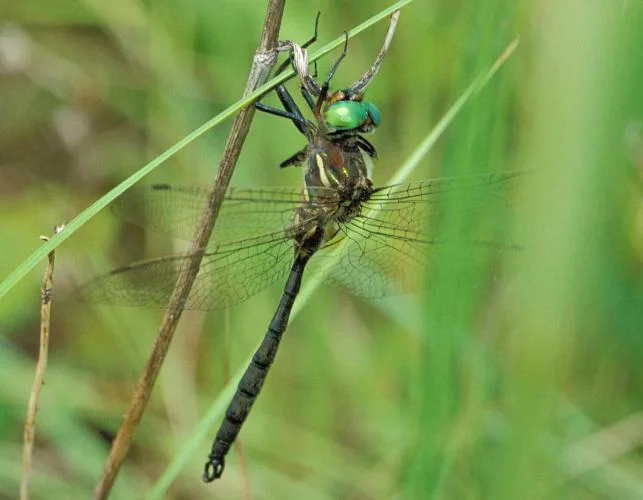
Scientific Name:Somatochlora hineana
Family:Corduliidae (emeralds) in the order Odonata (dragonflies and damselflies)
Description:The Hine’s emerald dragonfly is a federally endangered species. It has a dark emerald-green thorax and two yellow stripes on its sides. Newly emerged adults have dark brown eyes, but after about three days, they become brilliant iridescent emerald green.
There are more than 20 species of striped emeralds (genus Somatochlora) in North America north of Mexico. Learn more about the Hine’s emerald and other dragonflies (suborder Anisoptera) in their group entry.
Habitat and Conservation
The Hine’s emerald lives in calcareous spring-fed marshes and sedge meadows overlaying dolomite bedrock. Habitat destruction and degradation due to urban and industrial development has been the greatest problem for this dragonfly species. Habitats where it can live are few and far between, making it difficult or impossible for these dragonflies to move among them. If a population is eliminated from one locality, others will not be able to repopulate it.
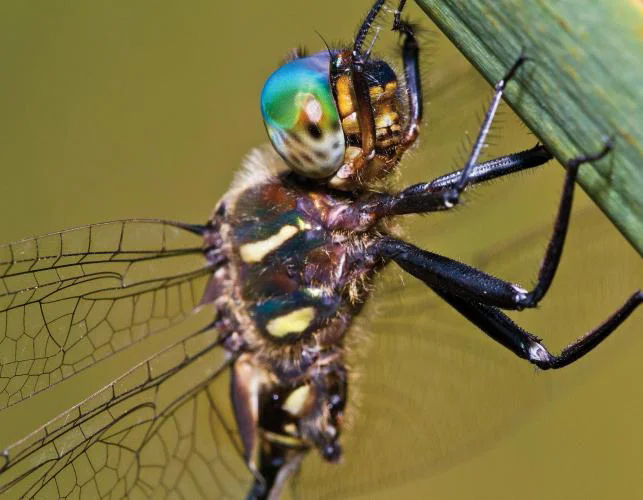
SAVING THE HINE’S EMERALD DRAGONFLY
The first known dragonfly fossil had a wingspan of 29 inches. The Hine’s emerald dragonfly, found in scattered locations throughout the Great Lakes region and Missouri, isn’t anywhere near that size, but it’s every bit as remarkable. Renowned for its aerobatic virtuosity and electrifying, enormous green eyes, the Hine’s emerald dragonfly hovers on the brink of extinction and is one of the most endangered dragonflies in North America today.
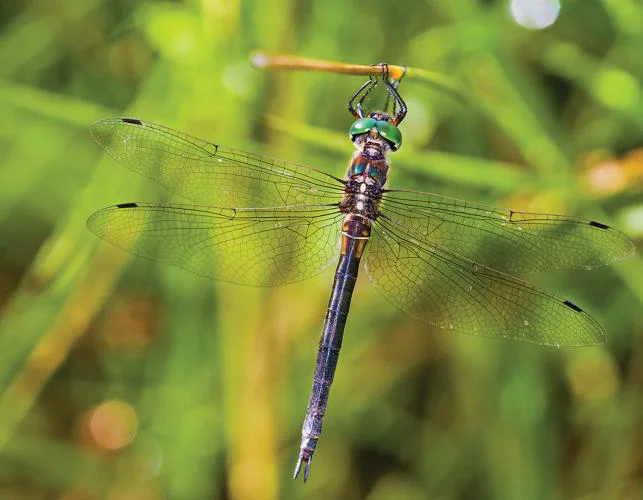
FEATURES
Hine’s emerald dragonfly is about two and one-half inches long with a wingspan of about three and one-third inches. It has bright green eyes and a metallic green body. There are yellow stripes on the side of the body.
BEHAVIORS
Hine’s emerald dragonfly lives in calcareous, spring-fed marshes and sedge meadows that grow over dolomite bedrock. In Illinois, all of those sites are close to the Des Plaines River. Adult males defend small breeding territories. The female lays eggs in shallow water. The eggs may hatch later the same year or overwinter and hatch the following year. The nymphs that emerge from the eggs live in the water for two to four years, molting numerous times. Nymphs eat aquatic insects. After the adult emerges, it lives for about one month, feeding on flying insects. Adults can be found from May through August. This species in endangered federally as well as in the state. The largest remaining breeding population is in Wisconsin. The only other known populations are in northeastern Illinois, northern Michigan and a site in Missouri. Habitat destruction is the main threat to this species, although use of pesticides and other pollutants and reduction in the amount and quality of water in the habitat are issues as well. Work is ongoing in northeastern Illinois regarding this dragonfly and its use of crayfish burrows. Nymphs are known to inhabit Devil crayfish (Cambarus diogenes) burrows during cooler times of the year. Studies are trying to determine if increasing the populations of Devil crayfish may be able to assist the survival of the dragonfly.




